Canon RF100-500 F4.5-7.1 L Lens Review: The Wildlife Photographer’s Pro Superzoom
A surprisingly tame coyote we found near a park road. He was pacing around for a while hunting and caching voles, and then finally settled down and just watched the silly photographers. Canon 100-500L, @186mm, ISO 1250, F/13, 1/60th
Introduction
As a wildlife and nature enthusiast, I’m always excited when a new telephoto lens is released to the market. Historically, these lenses have seemed like lower priorities for camera companies, but when they do come, it’s always time for celebration in the wildlife photography world. I thank the telephoto lens for getting me interested in nature photography to begin with, and for that reason they’ll always find a special place in my camera bag. Long live the telephoto!
As for the telephoto prime vs. zoom lens, well, I’ll admit I’ve always loved the sublime images one can make with a supertelephoto prime, and generally leaned in that direction. They usually offer a cleaner image, higher contrast and sharpness, more freedom over aperture control, and better performance than a zoom lens when it comes to action-centric photography. However, there’s no mistaking the versatile range of a telephoto zoom like Canon’s new RF 100-500L F/4.5-7.1, and also no ignoring that the advantage gap of primes over zooms continues to close.
I set out to find if these sentiments continue to ring true with the RF 100-500L - the first native zoom lens in the super telephoto range for the Canon RF mount.
A 50-second blend of 5-second exposures, ISO 100, 100mm, F/11.
Build and Feel
Dimensionally, the R5 is paired with this lens feels about the same size as a 5D with the 100-400 attached. How is that possible? The new lens is slightly longer than the 100-400 II, but the flange distance on the R5 is smaller than the 5D’s given the lack of a mirror box, which evens things out.
In most ways, the lens design is shared with the earlier Canon EF 100-400 F/4.5-5.6 II, but with the addition of 20% extra reach, a multi-function ring, and lightweight polycarbonate shell vs. the EF lens’s (mostly) metal design. Despite the more liberal incorporation of plastic build materials, the new lens feels quite solid in the hand.
Lens extended vs. collapsed attached to a gripped R5
As for nitpicks, I would have liked a rubber gasket around the front of hood to protect it from dings. While at first I thought it had one since the hood looks similar to the those found on Canon’s bigger super-teles, sadly it omits the rubber ring. Nothing a bit of gaffer tape can’t fix.
The second gripe I have is the telescoping front lens element. While this is a common design that is unchanged from the original 100-400 EF series lenses, I personally would have preferred an internal zoom like Sony’s 200-600 lens or Canon’s own EF 200-400. With an internal zoom, you do not need to fuss with a friction ring to mitigate lens creep, and those lens designs are arguably better sealed against water and dust ingress. I also found that I accidentally moved the friction ring when I thought I was moving the focus ring on several occasions – hopefully this will get better with muscle memory. Only time will tell if the lens can withstand normal use out in the wild, but at least the sealing diagrams and tear downs of other RF lenses reveal a pattern of robust build quality - and hopefully that’s the case.
Hand for scale
Because the front lens element on an internal-zoom lens moves, one must be slightly more aware of obstacles interfering with the front element or hood during zooming, as this lens telescopes over four inches at full extension. The other drawback I’ve found with externally zooming lenses is the actual zooming action being on the stiff side. Indeed the 100-500’s zoom ring feels just slightly too stiff even at the lowest friction setting, though thankfully it’s still possible to make small adjustments without too much trouble. The zoom throw is also farther than the Sony 200-600, for example, taking more than a 1/4” turn to cover the entire zoom range.
On the plus side, I’m thankful that the lens shaves a couple hundred grams off the older EF 100-400 II. It feels good and balanced in the hand, especially with the grip mounted to the R5, and I have no issue with hand holding the lens for a full day. Overall, we are talking about an almost 3/4-pound difference between the DSLR and mirrorless kit, which is significant if one is planning to travel with it. Of course, the key compromise of this collapsable lens design is that it provides for a dimensionally smaller optic that is much easier to pack and travel with - I suspect many will prefer this design for that reason.
I’m pleased that the lens collar is removable to save weight when needed, but it sadly lacks an integrated arca-swiss plate that is becoming more common on lenses of this type. My guess is they did this to shave a few grams to better market the weight advantages of the new lens.
Note: the lens collar does not have stops at 90-degree intervals, so you have to use the in-camera level or the indent marks at the top of the lens to make sure you’ve got a level horizon while using it on a tripod.
100-500L, ISO 500, 500mm, F/7.1, 1/320
Zoom range
What makes the 100-500 unique is the zoom feature. The addition of 20% extra reach on the long end over the original 100-400 EF lenses, coupled with the relatively generous 100mm on the wide end is significant for a lens in this class. In my testing, this enormous zoom range proved handy for a wide range of situations and subject matter. There were several times I found myself particularly appreciative of the wide-end. For example, the lens is equally at home capturing sweeping landscape panoramas as it is capturing closeups of small birds with remarkable detail. The addition of close focus ability up to .33X magnification also means it can be used like a pseudo-macro lens. Throw the 1.4X teleconverter on and you essentially have a 420-700mm macro.
500mm @ F/7.1, ISO 1250, 1/500th
What better way to demonstrate the zoom range than show the different focal lengths with an unusually cooperative Coyote? Although it probably seems like it, this coyote was not a zoo animal - and was in fact very wild. I am forever grateful for his cooperation during my lens test.
Of course, all that extra reach in a relatively compact lens comes at a cost, which is the F/7.1 minimum aperture on the long end. The F/7.1 sounds like a bummer until you take into account at least four things:
The Canon R5 can focus down to -6EV and apertures as low as F/22,
The R5’s low-ISO performance is outstanding (detail only really starts to take a hit after about 6400 ISO),
The lens is only a third of a stop darker at 400mm than the older EF lens. If you are used to using the original 100-400; think of it as the lens we know and love with a teleconverter permanently glued on.
The lens is relatively compact and lightweight for it’s type
Autofocus performance and tracking
One of the primary aspects of this lens that I was most interested in testing was the autofocus speed and tracking under demanding conditions, particularly at the longer end of the range. I was curious if the minimum F/7.1 aperture at 500mm (or F/10 @ 700mm with the 1.4 extender attached) presented any significant limitations when tracking fast moving subjects or autofocusing in less than ideal light.
700mm @ F/10, ISO 800, 1/500th
After getting a good feel for the camera and lens, my initial impressions are very positive overall. For “birds on sticks” or any other slow or stationary wildlife subjects, I think this is a fantastically reliable and enjoyable lens to use. The autofocus accuracy of this combination is uncannily accurate and fast; the behavior reminds me of some of the latest top-end DSLRs which are both bang-on accurate and blistering fast. Also, with the R5’s incredible image stabilization performance and steady hand and proper technique, one can easily drop the shutter speed down to 1/20th and get reliably sharp results while keeping the ISO’s comfortably low. This is really impressive performance for a full-frame camera.
I have yet to take the lens to some spots where I focus on birds in flight, so that will have to wait for a future update. Based on my initial experiences, the bare lens should have no problem with birds in flight, and I think the teleconverter attached would also do well in good lighting conditions. The pixel-peepers of the world shall note that drops in fine detail are noticeable upon close inspection above ~800 ISO, but overall picture noise and detail don’t really start to take a significant hit until above 6400. It’s nice knowing I can shoot at ISO 1250 all day long and not worry about it. In my mind, this impressive performance bolsters the use-case of this lens even in times when one is forced to use higher ISOs – which will be often with this lens.
700mm @ f/10, ISO 200, 1/320th
Teleconverters
It’s possible to squeeze even more reach out of the bare lens when either the RF 1.4 and 2.0X extenders are adapted. For my testing, I only had access to the 1.4x extender. I can thankfully report that it is it possible to get reliable focusing and truly impressive image quality with the extender attached. With the 1.4x extender attached, it means shooting at 700mm F/10. This would sound like a stretch in the days of old, but the R5 does an admirable job not only tracking the subject but maintaining a high keeper rate at these high F-stops.
In my mind, the key limitation of these extenders is that when paired with this lens, the lens must be locked in the 300-500mm range, and the 100-300 range becomes unusable. This reduces the use case of the teleconverters to those times when maximum reach is the priority, given the loss of versatility on the wide end. The following sample images show what’s possible with the 1.4 extender attached (@700mm)
700mm @ F/10, ISO 320, 1/200th
I do find storing the lens with the extender attached slightly irritating, because the zoom barrel must remain extended to that minimum 300mm position. While the extender works brilliantly, it drastically impacts the portability of the lens.
Still, based on how good the extender works, I think the RF 100-500 owner will want one on hand. For example, kingfishers are notoriously skittish in my area, but with the combination of the teleconverter attached and the R5’s high megapixel count, it’s possible to get decent shots of them. The following image demonstrates the latitude one has to crop even with the teleconverter attached and still retain impressive detail. This bird was at least 25-30 feet away.
Image quality
Years ago, you could got to a car dealership and easily make the mistake of buying a horrible lemon that spends most of its life in the shop and drives like a dog, while today, that’s actually difficult to do since most cars are at the very least “good”. I feel like the same thing rings true for new lenses - the image quality of most professional lenses today regardless of brand is generally superlative, with hair splitting differences between them that only test charts will decipher. In my eyes, the 100-500 lives up to this promise, and in my opinion provides excellent image reproduction.
500mm @ F/9.0, ISO 640, 1/60th
Crop of the image above
You’ll have to forgive my refusal to point the lens at a test chart or a brick wall, for what I have to say about the image quality is only subjective. That being said, I would sum things up by saying the RF 100-500 has met or exceeded expectations - in terms of sharpness, evenness throughout the frame, and low amounts of vignetting - which I find especially impressive for a lens with this much zoom range.
500mm @ F/7.1, ISO 1250, 1/500th
Who’s it for?
For the most likely use case, nature and wildlife photography, it seems like this lens could be all the serious enthusiast would ever need in the telephoto range. For the even more passionate and well-to-do shooter or professional, this one might feel like a bit of a hold-over until Canon’s RF super telephoto primes inevitably start coming out. That said, I think even those categories of buyers would find the lens incredibly versatile when the time calls for it. I could even see buyers that typically opt for 70-200 F/2.8 designs to choose this lens for added versatility.
3-image panorama, 100mm @ F/10, ISO 125, 1/200th
Close-up crop of the image above
For someone wanting to get into wildlife photography on the RF mount, this is essentially the only option right now without resorting to adapted glass - so the decision right now is fairly simple. The good news is it does not feel like settling at all, with this setup giving excellent performance one would expect from a professional lens and camera system. What went through my head while using this system was that the entire kit feels next-generation product, especially when the AF-Tracking modes are utilized.
Comparisons
While true side-by-side comparisons are beyond the scope of this review, I will close with some brief thoughts about the R5 and Canon 100-500 setup compared to alternatives.
First of all, the RF 100-500 has a lot going for it, but I would classify it as relevant for only a select subset of buyers - particularly those who have already invested in, or plan to invest in the R5 or R6 camera bodies which enable the best autofocus and optical stabilization system that Canon currently has to offer. Paired with those cameras, one can expect excellent performance and top-level image quality.
500mm @ F/7.1, ISO 1600, 1/500th
In the case of someone shooting with an older R cameras or Canon DSLR, a second hand 100-400 II, which is still a high-performing lens, would be a great alternative. Or, one could choose to wait for Canon to release the inevitable consumer-grade superzoom lens at a lower price point – but who knows when that will be released. The older 100-400 EF II lens would also be a solid choice if one owns both DSLRs and mirrorless and wants the luxury of using the same lens on both systems.
For those not married to the Canon ecosystem who are considering other available systems, the closest comparison that I would make right now would probably be the either the Sony 100-400 or 200-600 lenses paired with the a7RIV. While my past experiences with the a7RIV with tele-zooms was a mixed bag, I’ve heard that new firmware updates have rectified some of the early autofocus problems I experienced with that camera. That 200-600 is an incredible value, and I really do like Sony’s Realtime Tracking AF, in some ways preferring it over Canon’s subject tracking implementation. I also suspect bird eye AF tracking is not far down the pipeline for Sony, since they were the early pioneers of eye-AF. In many ways, I’m equally impressed with the Sony offerings, and so I’d recommend anyone considering both systems to rent them if possible and see how well they get along with each. My personal feeling is that image quality at normal viewing distances with similar lenses on the same format is likely to be a wash, so personal preferences become far more important.
Depending on your frame of reference, the 100-500 is also not a small lens. Someone not keen on the size might be better suited with a micro-four thirds setup, e.g., the Panasonic Leica 50-200 F/2.8-F/4.0, which will be far smaller than this and also takes teleconverters. Though not an apples to apples comparison, the equivalent focal range covered by the two lenses is similar.
The person who is only interested in the reach and wants to stay with Canon, the new 600 F/11 could also work – I’m just not a big fan of these designs (for reasons I won’t get into here).
My impression is that, true to Canon fashion, the Canon RF system now has a lot to offer the wildlife shooter with this lens, and it’s only likely to get better. The R5 and R6 have the current spotlight as two of the most impressive mirrorless cameras around, and the inevitability of more telephoto lens selections in the future holds promise for wildlife enthusiasts that are willing to be patient. It’s exciting times for sure - and I hope Canon continues to push the envelope on lens innovation and unique designs like the 100-500 L.
I will update this page with more sample images as I get more time with the lens. Feel free to drop me a line in the comments if you have any questions about the review.


































